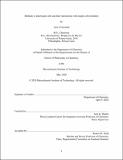Methods to interrogate cells and their interactions with single-cell resolution
Author(s)
Genshaft, Alexander S.
Download1197080307-MIT.pdf (8.107Mb)
Other Contributors
Massachusetts Institute of Technology. Department of Chemistry.
Advisor
Alex K. Shalek.
Terms of use
Metadata
Show full item recordAbstract
Only recently have molecular methods achieved high-quality and unbiased representations of diverse intracellular molecules at the single-cell level. With this technological advancement, researchers have begun deconvolving population-level measurements to understand whether prior observations were homo- or heterogeneous across the sample. In order to make multi-omics workflows compatible with low input samples comprising a few to single cells, new methods are required. Here, we devise a scalable, integrated strategy for coupled protein and RNA detection in single cells. This method and other similar protocols enable researchers to dive deeper into cellular phenotypes while retaining single-cell resolution, critical for determining what transcriptional programs arise and in which cells with what other programs. However, cellular phenotypes are not solely determined by the products of transcription and translation - cells are constantly receiving information from their environment including direct contact with other cells, secreted biomacromolecules and small molecules. To explicitly examine how a cell's spatiotemporal activity impacts its behavior, we developed and validated SPACECAT: a strategy to annotate, track, and isolate specific cells in a non-destructive, viability-preserving manner. To accomplish this goal, we created a novel photocaged viability dye and incorporated other photoactivatable fluorophores that we can combine to create five distinct fluorescence signatures. We show that the SPACECAT protocol is a powerful tool for targeting specific microenvironments to reveal phenotypes that would otherwise be obscured by bulk signatures. However, SPACECAT does not capture precise interaction history with defined cell types and cannot track secreted molecules. To exert more control over cellular interactions, we created a protocol that confines interacting cliques of cells to microwells, preventing cells or secreted molecules from leaving their well of origin, and isolating them from the many other cliques interrogated in parallel. By examining cliques under biological, chemical, and null control stimuli, we see distinct transcriptional programs that underly immunological interaction between CD4+ T cells and antigen presenting cells. Through these novel methods and their proof-of-principle applications, we enable researchers & clinicians to delve further into their systems of interest.
Description
Thesis: Ph. D., Massachusetts Institute of Technology, Department of Chemistry, May, 2020 Cataloged from the PDF of thesis. Includes bibliographical references.
Date issued
2020Department
Massachusetts Institute of Technology. Department of ChemistryPublisher
Massachusetts Institute of Technology
Keywords
Chemistry.